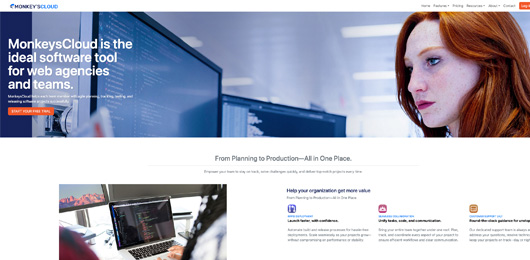Selected work across Drupal, PHP, JS, Python, and Go—with measurable outcomes.
ColibriCode is a Denver-based engineering workshop. These stories show how we help teams stabilize legacy platforms, launch new products, and add the kind of observability that turns chaos into a roadmap.
Every engagement combines a tailored mix of Drupal/PHP work, frontends (React/Next.js), Python/Go services, and DevOps. We care less about buzzwords—and more about pages loading faster, incidents going down, and teams feeling in control again.
WHAT YOU’LL SEE BELOW
- Context: who the client is, what industry they’re in, and which stack they were wrestling with.
- The challenge: the real constraints—legacy platforms, incidents, or performance issues.
- The solution: how we combined Drupal, PHP, JS, Python, Go, and DevOps to move the needle.
- Impact: metrics and qualitative changes that matter to the business.
If you recognize your situation in any of these, we can likely adapt the same patterns to your context, without forcing a one-size-fits-all template.
CASE STUDIES
Filter by theme and dive into the details.
DEEP DIVE
How we approached this project.
Below is a more detailed view of one selected case study. The patterns here—thin slices, clear metrics, and a mix of Drupal/PHP, JS, Python, Go, and DevOps—tend to repeat across our work.

MonkeysCloud: All-in-one DevOps & Project Platform
MonkeysCloud (internal product) • Web Agencies & Dev Teams • 2025
DURATION
9 months to v1 • Ongoing evolution
STACK
Symfony APIs + Next.js app + Python workers + Drupal 10 site + Terraform
KEY SERVICES
METRICS WE CARE ABOUT
We try to anchor every engagement to a handful of concrete signals—performance, reliability, user behavior, or operational load—so it’s obvious whether we’re moving in the right direction.
Project Setup Time
Hours → Minutes
Manual Server Work
↓ ~70%
Deployment Consistency
Standardized via Terraform
Managed Projects Capacity
↑ ~30% per team
THE CHALLENGE
Agencies were juggling separate tools for tasks, Git, deployments, and server management. Onboarding a new project meant repeating the same manual steps across snowflake servers, and there was no single place to see the health of projects, repos, and environments.
OUR APPROACH
We built a Symfony-based API as the core brain, a Next.js app as the main control panel, and Python workers for background jobs like backups, health checks, and analytics. A Drupal 10 site powers the public marketing layer. Terraform codifies the entire infrastructure so projects, environments, and networks can be provisioned reproducibly across cloud providers.
IMPACT ON THE TEAM
- Agencies can spin up new customer projects with a repeatable template instead of ad-hoc servers.
- Developers see tasks, branches, pipelines, and environments in one place instead of five tools.
- Platform-level automation (backups, monitoring, deploy hooks) reduces the cognitive load on each individual project.
How this might translate to your context
You don’t need to have the exact same stack to benefit from these patterns. If you’re wrestling with slow Drupal/PHP apps, a React or Next.js frontend that feels fragile, or Python/Go workers without observability, we can carve out a small, high-impact slice as a starting point.
HOW WE MEASURE SUCCESS
Not just “it shipped”—we care about what changed afterward.
In most of our case studies, we look at three dimensions: user-facing experience, operational load on your team, and how easy it is to evolve the system after we’re gone.
User-facing outcomes
- Performance and reliability of critical flows.
- Conversion, retention, and satisfaction signals.
- How confident product/design feel demoing or using the system live.
Operational outcomes
- Incident volume and severity over time.
- On-call load and time spent firefighting.
- How easy it is to understand what production is doing.
Long-term outcomes
- Upgrade paths for Drupal, PHP, JS, Python, and Go pieces.
- How quickly your team can ship new features on top.
- Whether new engineers can onboard without tribal knowledge.
CASE STUDY QUESTIONS
A few things teams usually ask after seeing these stories.
Do these case studies represent typical budgets?
Each project here represents a meaningful engagement, usually a few months of focused work with a small senior team. We’re happy to calibrate based on your context and constraints.
Can you share more details or references?
Yes. After a quick intro call and NDA where needed, we can share more specific details, architecture notes, or arrange reference calls if there’s a strong mutual fit.
Can we start with something smaller than a full rebuild?
Absolutely. Many of these projects started as a narrow slice—performance pass, a new dashboard, a single workflow—and expanded once value was clear.
TALK ABOUT YOUR OWN CASE
If you’re seeing your situation between the lines, let’s compare notes.
Send us a short description of your stack (Drupal, PHP, React, Python, Go, cloud), where it hurts today, and what “better” would look like. We’ll respond with a concrete, small starting slice—whether or not we end up working together.
We’re based in Denver, USA and usually work with teams in North America and Europe, with overlapping hours and English-first communication.